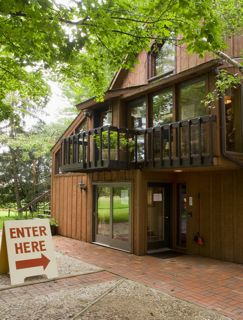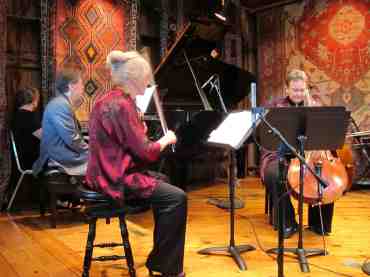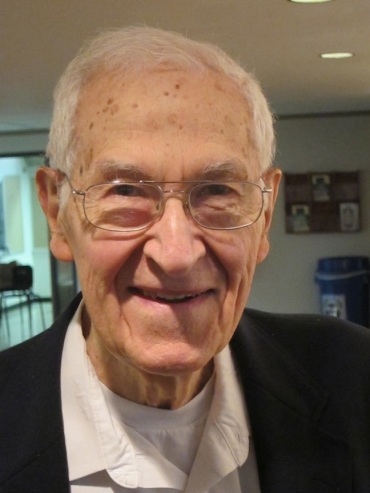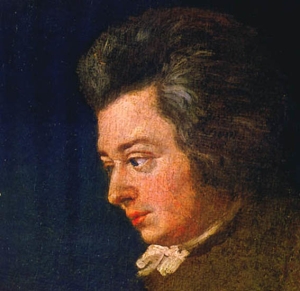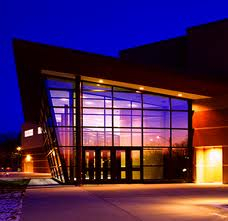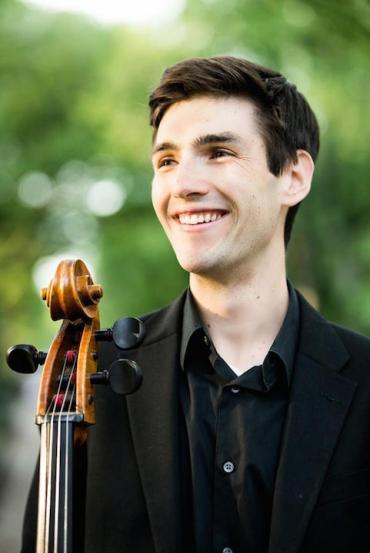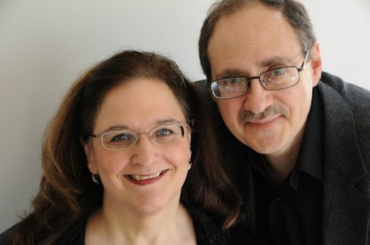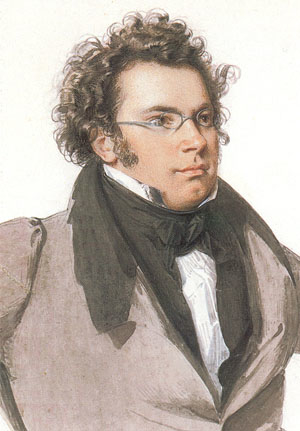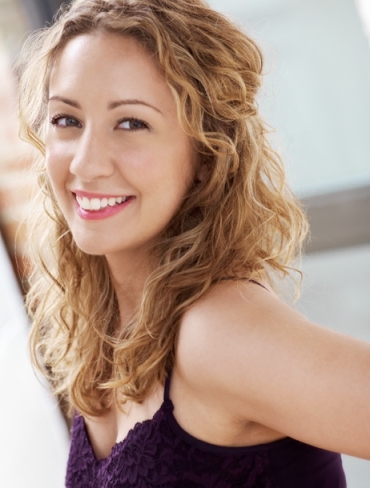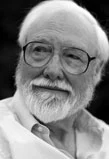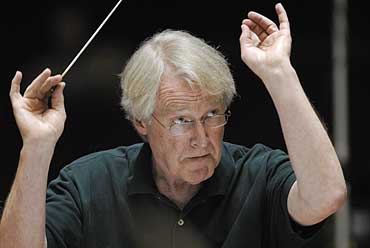The Well-Tempered Ear
The Madison New Music Festival launches the Wisconsin Composers Project with a virtual online concert this Friday night, Sept. 25
Leave a Comment
PLEASE HELP THE EAR. IF YOU LIKE A CERTAIN BLOG POST, SPREAD THE WORD. FORWARD A LINK TO IT OR, SHARE IT or TAG IT (not just “Like” it) ON FACEBOOK. Performers can use the extra exposure to draw potential audience members to an event. And you might even attract new readers and subscribers to the blog.
By Jacob Stockinger
The Ear has received the following announcement to post:
The Madison New Music Festival is pleased to announce the launch of the Wisconsin Composers Project.
Both a community resource and annual series, the project consists of a database and a virtual concert meant to increase composers’ visibility and encourage local curators and performers to collaborate with their neighbors.
We invite all Wisconsin-affiliated composers to sign up to be included in the database on our website: https://madisonnewmusic.org/aboutwcp
Please join us for the live streaming event of the Wisconsin Composers Project Concert on this Friday night, Sept. 25, at 7:30 p.m. CDT on our website at https://madisonnewmusic.org and enjoy new music from all over Wisconsin from the comfort and safety of your home.
The pre-recorded concert will profile five Wisconsin-based composers (below) and performances of their works, one of which refers to the pandemic quarantine.
Audience members will hear directly from the composers about their music and influences, and enjoy the diversity of the Wisconsin musical community.
Featured composers and their works include:
Brent Michael Davids (above, top left): In Wisconsin Woods, performed by the composer. (In the YouTube video at the bottom, you can hear the UW-Whitewater Chamber Singers and the Medicine Bear Singers perform “Sanctus: Singing for Power” from Davids’ Requiem for America.)
Jerry Hui (above, top right), a UW-Madison graduate who now teaches at UW-Stout: Quarantine Canzonets, performed by soprano Jennifer D’Agostino and baritone Michael Roemer.
Laura Schwendinger (above, bottom left), an internationally recognized and prize-winning composer and UW-Madison professor: All the Pretty Little Horses, performed by cellist Trace Johnson.
Asha Srinivasan (above, top center): Dyadic Affinities, performed by tubist Tom Curry.
Lawren Brianna Ware (above, bottom right): Borealis, performed by the composer.
The suggested donation to stream this concert is $15 per person.
For more information, please visit our website at madisonnewmusic.org or find us on Facebook (@Madison New Music Festival) or Instagram (@madisonnewmusic).
Tags: #AllthePrettyLittleHorses, #AshaSrinivasan, #BaritoneSinger, #BlogPost, #BlogPosting, #BrentMichaelDavids, #CelloMusic, #ChamberMusic, #ChoralMusic, #CityofMadison, #CoronavirusPandemic, #COVID-19, #FacebookPost, #FacebookPosting, #FacultyMember, #Fridaynight, #HomeWebsite, #InstagramPost, #JacobStockinger, #JenniferD'Agostino, #JerryHui, #LauraSchwendinger, #LawrenBriannaWare, #LiveStreaming, #LivingComposer, #MadisonNewMusicFestival, #MadisonWisconsin, #MeadWitterSchoolofMusic, #MedicineBearSingers, #MichaelRoemer, #Musicfaculty, #NativeAmerican, #NativeAmericanmusic, #NewMusic, #Prize-Winning, #RequiemforAmerica, #Self-Isolation, #SignUp, #SopranoSinger, #StateOfWisconsin, #TheEar, #TheUW, #TomCurry, #TraceJohnson, #TubaMusic, #UniversityofWisconsin-Madison, #UW-WhitewaterChamberSingers, #VirtualConcert, #VocalMusic, #WisconsinComposersProject, #YouTubevideo, affiliation, affinity, all, America, announcement, annual, Arts, Asha Srinivasan, audience, baritone, blog, Borealis, Brent Michael Davids, canzonet, canzonetta, cellist, Cello, cello music, celo, Chamber music, choral music, Classical music, collaborate, community, composer, Composition, Concert, coronavirus, curators, databse, diverse, diversity, donation, dyad, encourage, enjoy, Facebook, faculty, faculty member, featured, forward, Friday, graduate, home website, horse, includ, include, increase, information, Instagram, international, invite, isolation, Jacob Stockinger, Jennifer D'Agostino, Jerry Hui, launch, Laura Schwendinger, Lawren Brianna Ware, like, link, little, live streaming, live-stream, livestream, Living composer, local, Madison, Madison New Music Festival, Mead Witter School of Music, medicine, Medicine Bear Singers, Michael Roemer, more, Music, music faculty, musical, Native American, Native American music, neighbors, New Music, night, online, Orchestra, pandemic, performer, performers, post, posting, power, pre-recorded, pretty, professor, profile, recognized, Requiem, Requiem for America, resource, Sanctus, series, share, sign-up, singers, Singing, soprano, stream, subscriber, suggested, tag, The Ear, Tom Curry, Trace Johnson, Tuba, tubist, United States, University of Wisconsin-Madison School of Music, University of Wisconsin–Madison, UW, UW-Madison, UW-Stout, UW-Whitewater, UW-Whitewater Chamber Singers, virtual, visibility, vocal music, Website, Wisconsin, Wisconsin Composers Project, Woods, works, YouTube
Classical music: This summer the Token Creek Festival goes online. The music starts TODAY at 4 p.m. Concerts run daily through Sept. 15 and remain up for this month
2 Comments
PLEASE HELP THE EAR. IF YOU LIKE A CERTAIN BLOG POST, SPREAD THE WORD. FORWARD A LINK TO IT OR, SHARE IT or TAG IT (not just “Like” it) ON FACEBOOK. Performers can use the extra exposure to draw potential audience members to an event. And you might even attract new readers and subscribers to the blog.
By Jacob Stockinger
The annual Token Creek Chamber Music Festival normally occurs in the final weeks of summer, just before Labor Day, in the welcoming rustic comfort of the beautifully converted barn (below) located on the rural farm property of composer John Harbison and violinist Rose Mary Harbison.
With its normal concert season canceled due to Covid-19, the festival is pleased to announce an alternative for the summer almost ended.
Slightly later than usual, “MUSIC FROM THE BARN” is a two-week virtual season, a retrospective of concert compilations from 30 years of performances.
The topical programs will be released daily over the period Sept. 1–15 at 4 p.m. (CDT), and will remain posted and available to “attendees” throughout the month. From anywhere in the world, you can revisit whole programs or individual pieces.
The goal of the series has been to achieve the broadest possible representation of repertoire and artists who have graced the Token Creek stage since the series began in 1989.
To festival-goers, it will come as no surprise that the virtual season emphasizes music of Bach, Mozart, Haydn, and Beethoven, vocal music, works by artistic director John Harbison and his colleagues, and, of course, jazz.
In addition to the welcoming beauty of the barn and festival grounds, with sparkling creek and abundant gardens and woods, and the convivial intermissions at every concert, one of the features most beloved by audiences is the concert introduction by Pulitzer Prize-winning composer, MacArthur “Genius Grant” recipient and MIT professor John Harbison (below) that begins each program. Happily, these remain a feature of the virtual season as well.
Season Schedule
Tues., Sept. 1: Welcome and introduction from the artistic directors (below and in the link to the YouTube video at the bottom)
TODAY, Wed., Sept. 2: Founders Recital
Thurs., Sept. 3: Haydn Piano Trios
Fri., Sept. 4: Bach I: Concertos
Sat., Sept. 5: A Vocal Recital (I)
Sun., Sept. 6: Beethoven
Mon., Sept. 7: Contemporaries
Tues., Sept. 8: Early Modernists
Wed., Sept. 9: A Vocal Recital (II): Schubert and Schumann
Thurs., Sept. 10: Jazz 2003-2019
Fri., Sept. 11: Neo-classicists: Pizzetti, Martinu, Stravinsky
Sat., Sept. 12: Schoenberg and His Circle
Sun., Sept. 13: Mozart
Tues., Sept. 14: John Harbison: Other Worlds
Wed., Sept. 15: Bach II: Preludes, Fugues, Arias, Sonatas
Programs will be posted on Token Creek’s YouTube Channel, accessible from the festival website (https://tokencreekfestival.org), which will also host concert details: works, artists, program notes and other information.
All concerts are FREE and open to the browsing public.
In addition to the virtual concert season, the Token Creek Festival is pleased to release two new CDs.
A Life in Concert (below) features music written for Rose Mary Harbison by John Harbison, and performances of diverse music by the two of them. It includes the world premiere recordings of Harbison’s Violin Sonata No. 1 and Crane Sightings: Eclogue for Violin and Strings, inspired by frequent encounters with a pair of sandhill cranes at the Wisconsin farm.
Wicked Wit, Ingenious Imagination (below) offers four piano trios by Haydn, a beloved genre the festival has been surveying regularly since 2000. CDs will be available at the festival website by mid-September.
For more information, go to: https://tokencreekfestival.org
https://tokencreekfestival.org/2020-virtual-season/welcome/#
Tags: #ALIfeinConcert, #AmericanJazz, #ArnoldSchoenberg, #ArtisticDirector, #AtonalMusic, #BachCantata, #BaroqueMusic, #BlogPost, #BlogPosting, #BohuslavMartinu, #ChamberMusic, #ClassicalRecording, #ConcertSeason, #CoronavirusPandemic, #COVID-19, #CraneSightings, #FacebookPost, #FacebookPosting, #FacultyMember, #FranzJosephHaydn, #FranzSchubert, #GeniusGrant, #IgorStravinsky, #InstrumentalMusic, #JacobStockinger, #JohannSebastianBach, #JohnHarbison, #LaborDay, #LudwigVanBeethoven, #MacArthurFellow, #MacArthurFoundation, #MassachusettsInstituteofTechnology, #Musicfaculty, #MusicFromtheBarn, #MusicProfessor, #NeoClasssicalMusic, #NewMusic, #OnlineConcert, #PianoTrio, #ProgramNotes, #PulitzerPrize, #RobertSchumann, #RoseMaryHarbison, #SandhillCranes, #StateOfWisconsin, #StringMusic, #TheEar, #TokenCreekChamberMusicFestival, #TokenCreekFestival, #TwelveTone, #UWProfessor, #ViolinSonata, #VirtualConcert, #VocalMusic, #Wicked Wit, #WolfgangAmadeusMozart, #WorldPremiere, #YouTubeChannel, #YouTubevideo, A Life in Concert, abundant, alternative, announce, annual, anywhere, aria, Arnold Schoenberg, Artistic director, artists, Arts, atonal, attendee, Bach, barn, Baroque, beautiful, beauty, Beethoven, blog, Bohuslav Martinu, broad, browsing, canceled, Cantata, CDs, cellist, Cello, Chamber music, channel, co-artistic director, colleagues, comfort, compilation, composer, concert season, concerti, concertos, contemporary, converted, convivial, coronavirus, crane, creek, daily, details, diverse, diversity, early, Early music, Eclogue, emphasize, encounter, end, Facebook, faculty, farm, feature, festival, festival-goers, forward, founders, Franz Joseph Haydn, Franz Schubert, free, fugue, Garden, gardens, genius grant, goal, grace, grounds, Haydn, Holiday, Igor Stravinsky, imagination, individual, information, ingenious, Ingenious Imagination, IngeniousImagination, instrumental music, intermission, introduction, Jacob Stockinger, Jazz, Johann Sebastian Bach, John Harbison, Labor Day, later, life, like, link, Ludwig van Beethoven, Martinu, Massachusetts Institute of Technology, MIT, modern, modernists, month, Mozart, Music, Music From the Barn, music professor, neoclassical, neoclassicists, New Music, normal, normally, occur, online, online concert, open, other, pair, pandemic, performance, period, Piano Trio, piece, Pizzetti, pleased, post, posting, Prelude, program, program notes, property, public, Pulitzer Prize, recipient, recital, recording, release, remain, repertoire, repertory, representation, retrospective, revisit, Robert Schumann, Rose Mary Harbison, rural, rustic, sale, sandhill cranes, schedule, Schoenberg, Schubert, Schumann, Season, sell, September, share, sighting, singer, Singing, Sonata, sparkling, stage, Stravinsky, string music, strings, summer, surprise, tag, The Ear, today, Token Creek Chamber Music Festival, Token Creek Festival, topical, twelve tone, two, usual, Viola, Violin, Violin Sonata, violinist, virtual, vocal, vocal music, week, welcome, welcoming, whole, Wicked, Wisconsin, wit, Wolfgang Amadeus Mozart, Woods, works, world, world premiere, years, YouTube
Classical music: University Opera succeeded brilliantly by setting Britten’s “A Midsummer Night’s Dream” in the 1960s at Andy Warhol’s The Factory
2 Comments
PLEASE HELP THE EAR. IF YOU LIKE A CERTAIN BLOG POST, SPREAD THE WORD. FORWARD A LINK TO IT OR, SHARE IT or TAG IT (not just “Like” it) ON FACEBOOK. Performers can use the extra exposure to draw potential audience members to an event. And you might even attract new readers and subscribers to the blog.
By Jacob Stockinger
Larry Wells — the Opera Guy for this blog – took in two performances last weekend of the University Opera’s production of Benjamin Britten’s “A Midsummer Night’s Dream,” which played to three sold-out houses at Music Hall. He filed this review. Performance photos are by Benjamin Hopkins and Michael Anderson.
By Larry Wells
The University Opera’s production of Benjamin Britten’s “A Midsummer Night’s Dream” was set in Andy Warhol’s Factory of the 1960s with countertenor Thomas Alaan (below) as a Warhol-like Oberon presiding over the antics.
The opera by Britten (below) follows Shakespeare’s play fairly closely. The magical transformations and herbs of the original were translated to a hallucinogen-filled milieu of go-go dancing fairies, master-slave relationships and same-sex liaisons.
And for me it worked. That is to say, this production contained the same strangeness and wonder as the traditional productions I have seen. The play itself is very strange and wonderful.
Alaan is a fine singer and played a manipulative and somewhat slimy Warhol/Oberon whose flat affect seemed to be reflected in the relative lack of expressivity in the voice. Pitted against Oberon were Amanda Lauricella and Kelsey Wang alternating as Tytania.
Although the program stated that the portrayal of Tytania was loosely based on Edie Sedgwick in this production, without the platinum hair I missed the references. Both portrayals were much more assertive than Edie ever was, and both singers’ ardent coloratura voices tended to overshadow Oberon’s, which may have been intentional. Wang (below, far right) was an intense actress who put sparks into her portrayal, while Lauricella really has a superb voice.
(Below, from left, are Michael Kelley as Puck; Thomas Alaan as Oberon; Tanner Zocher as a young man; and Kelsey Wang as Tytania.)
The four lovers (below left) seemed to be employees at The Factory. Tenor Benjamin Liupaogo portrayed Lysander. The vocal part has an uncomfortable upper range, but Liupaogo’s singing in the second act particularly was up to the challenge.
His rival Demetrius was portrayed by baritone Kevin Green. Their contending affections for Hermia and Demetrius’ initial scorn for Helena were oddly lacking in ardor.
Hermia was double cast with Julia Urbank, a promising soprano, and Chloe Agostino, who was also a very good singer. Poor Helena, first ignored and then pursued by both men, was also double cast with a terrific Rachel Love and an equally gifted Jing Liu.
(The four lovers, below from left, were: Benjamin Liupaogo as Lysander; Chloe Agostino as Hermia; Jing Liu as Helena;, Kevin Green as Demetrius; and Paul Rowe as Theseus with Lindsey Meekhof as Hippolyte.)
As I have noted before, the female singers in the opera program often seem to be very solid performers. (You can hear the lovers’ quartet in the YouTube video at the bottom.)
And then there were the “Rustics” (below), the workers who have come together to put on the play “Pyramus and Thisbe” for the upcoming wedding of the local duke, or in this case a rich art patron.
(The six rustics, below from left, were: James Harrington as Bottom; Jacob Elfner as Quince; Benjamin Galvin as Snug; Jack Innes as Starveling; Thore Dosdall as Flute; Jeffrey Larson as Snout; with Kevin Green as Demetrius, seated.)
The six men were each talented comic actors and provided many of the performance’s laughs. Foremost was James Harrington’s Bottom. Not only a very funny actor, he produced in my opinion the finest singing among the many talented students.
Mention must be made of the very amusing Flute, hysterically portrayed by Thore Dosdall, and the promising bass Benjamin Galvin as the slow learner Snug.
These men not only sang well together and separately, but also provided many guffaws whenever they appeared. (Below are: Jacob Elfner as Quince; Jeffrey Larson as Snout; James Harrington as Bottom; Jack Innes – back row up on box – as Starveling; Benjamin Galvin as Snug; and Thore Dosdall as Flute.)
Additionally we had the fairies — all female voices in this production — who sounded wonderful together and got to demonstrate their incongruous ‘60s dance moves to Britten’s score.
Professor Paul Rowe (below left, with Lindsey Meekhof as Hippolyta) made an appearance as Theseus, the duke. His singing was that of a mature artist, a quality to which the students are clearly aspiring.
As the opera drew to a close with a beautifully harmonious chorus, one felt the transformation from dissonance to harmony in the opera and conflict to resolution embodied in the original play.
Many mentions of woods and forest are made in the libretto. Director David Ronis had the walls of the factory cleverly hung with changing arrays of Warhol-like multiple images of flowers and animals. With the amount of weed being smoked and who knows what being ingested onstage, it was easy to believe that the characters might think they were in a forest despite being in a Manhattan warehouse (below).
(The cast, below from left, included Amanda Lauricella and Thomas Alaan in the foreground as Tytania and Oberon. Others were: Julia Urbank on the floor; Benjamin Liupaogo, on the floor; Chloe Flesch; Maria Steigerwald; Amanda Lauricella; Maria Marsland; Angela Fraioli; Thomas Aláan; and James Harrington lying on the couch.)
Presiding over all of this were members of the UW Symphony Orchestra led by new conductor Oriol Sans (below). I have heard maestro Sans conduct the students several times this fall, and I feel he is an outstanding addition to the music school. His control over the forces was amazing, and the subtlety he drew from the players was remarkable.
Ronis (below, in a photo by Luke Delalio) has tried original twists in several of his previous productions, but I think this has been the most outlandish. And I have to say that I really loved it. So carry on, please.
He has a penchant for Britten, one of my favorite composers. His previous productions included “Albert Herring” and “Turn of the Screw.” I wonder if readers have suggestions for another Britten opera he could conceivably produce here. I have my own wish list.
Tags: #AlbertHerring, #AMIdsummerNight'sDream, #AndyWarhol, #ArtPatron, #BaritoneSinger, #BenjaminBritten, #BenjaminLiupaogo, #BlogPost, #BlogPosting, #BlogReview, #ChoralMusic, #CountertenorSinger, #DavidRonis, #DrugsandAlcohol, #EdieSedgwick, #EmeritusProfessor, #FacebookPost, #FacebookPosting, #LarryWells, #Master-Slave, #MeadWitterSchoolofMusic, #MusicHall, #MusicReview, #MusicSchool, #OrchestralAccompaniment, #OriolSans, #PaulRowe, #PopArt, #SopranoSinger, #TenorSinger, #The1960s, #TheaterReview, #TheEar, #TheFactory, #TheOperaGuy, #TurnoftheScrew, #UniversityofWisconsin-Madison, #UniversityOpera, #UWProfessor, #UWSymphonyOrchestra, #VocalMusic, #WilliamShakespeare, #WishList, #YouTubevideo, 1960s, A Midsummer Night's Dream, Actor, actress, affect, affection, Albert Herring, alcohol, amazing, Andy Warhol, animal, antics, ardent, Art, art patron, artist, Arts, aspire, assertive, baritone, beautiful, Benjamin Britten, Benjamin Liupaogo, blog, Britten, cast, challenge, characters, choral music, chorus, Classical music, coloratura, comic, composer, conductor, conflict, contend, control, countertenor, dance, dancing, David Ronis, director, dissonance, dream, drugs, duke, Edie Sedgwick, employee, expressivity, Facebook, factory, fairies, fairy, favorite, females, flat, flowers, forces, forest, forward, funny, gifted, go-go, guffaw, hair, hallucinogens, harmonious, harmony, herb, herbs, House, houses, hysterical, image, incongruous, ingest, intense, Jacob Stockinger, Larry Wells, laughs, learner, liaison, libretto, like, link, local, lover, Madison, magic, magical, male, MANHATTAN, manipulative, mature, Mead Witter School of Music, member, men, mention, milieu, move, Music, Music Hall, music review, music school, Oberon, onstage, opera, opera music, Orchestra, original, Oriol Sans, outlandish, outstanding, overshadow, patron, Paul Rowe, penchant, photos, platinum, play, pop, Pop art, portrayal, post, posting, preside, presiding, produce, produced, production, professor, promising, Puck, quality, range, reference, relationship, remarkable, resolution, rich, rustic, same-sex, score, scorn, Shakespeare, share, sing, singer, Singing, slimy, smoke, sold-out, soprano, sparks, strange, strangeness, subtlety, suggest, suggestion, summer, superb, tag, talent, talented, terrific, The Ear, The Factory, The Opera Guy, theater review, traditional, transformation, Transformations, translated, Turn of the Screw, twist, Tytania, uncomfortable, United States, University of Wisconsin-Madison School of Music, University of Wisconsin–Madison, University Opera, upper, UW, UW Symphony Orchestra, UW-Madison, UW-Madison Mead Witter School of Music, video, vocal music, voice, wall, warehouse, Warhol, wedding, weed, William Shakespeare, Wisconsin, wish list, women, wonder, Woods, workers, YouTube
Classical music: TONIGHT one longtime, generous classical music patron honors another with a FREE public, all-Schubert memorial concert at Oakwood Village West
2 Comments
PLEASE HELP THE EAR. IF YOU LIKE A CERTAIN BLOG POST, PLEASE SPREAD THE WORD. FORWARD A LINK TO IT OR, SHARE IT or TAG IT (not just “Like” it) ON FACEBOOK. Performers can use the extra exposure to draw potential audience members to an event. And you might even attract new readers and subscribers to the blog.
By Jacob Stockinger
Think of it as a well-deserved, heart-felt homage that one longtime and generous patron of classical music is paying to another patron who also happened to be a close personal friend and a professional colleague.
The public is invited to join in the one-hour, FREE all-Schubert memorial concert at Oakwood Village West (University Woods), at 6205 Mineral Point Road, on Madison’s far west side near West Towne Mall, at 7 p.m. TONIGHT, Oct. 19.
Here is an invitation from retired University of Wisconsin-Madison chemist Kato Perlman (below) about the concert she is sponsoring and funding in memory of her close friends:
“Join flutist Iva Ugrcic (below top) and pianist Thomas J. Kasdorf (below middle) for a FREE All-Schubert Evening and enjoy the music from one of the greatest composers of the 19th century, Franz Schubert (1797-1828, below bottom).
“This concert is in memory of the late Irving and Millie Shain. Irv Shain (below) was a chemistry professor and then a long-serving Chancellor of the University of Wisconsin, and a great supporter of the University of Wisconsin-Madison Mead Witter School of Music.
“He played the flute himself and these Schubert pieces belonged to some of his favorites for the flute.
“He also established, in addition to his long-running annual Beethoven piano sonata competition, a woodwind and piano competition. Both Iva Ugrcic and Thomas Kasdorf are previous winners.”
The program is:
Sonata in A Minor, D. 821 (“Arpeggione”)
Introduction and Variations on “Trockne Blumen” (Withered Flowers) from “Die Schöne Müllerin” (The Beautiful Miller’s Daughter), D. 802 (Op. 160)
Ständchen (“Serenade”) from Schubert’s final song cycle Schwanengesang (Swan Song), D. 957 (heard in the YouTube video below)
Tags: #19thCentury, #ArpeggioneSonata, #ArtsPatron, #BlogPost, #BlogPosting, #ChamberMusic, #DieSchöneMüllerin, #DieSchoeneMullerin, #FacebookPost, #FacebookPosting, #FluteMusic, #FranzSchubert, #IntroductionandVariations, #IrvingShain, #IvaUgrcic, #KatoPerlman, #LudwigVanBeethoven, #MeadWitterSchoolofMusic, #MusicSchool, #OakwoodVillageWest, #One-Hour, #PianoAccompaniment, #PianoAccompanist, #PianoSonata, #SchoolofMusic, #SongCycle, #SwanSong, #SwanSongs, #TheEar, #ThemeAndVariations, #ThomasKasdorf, #UniversityofWisconsin-Madison, #UniversityWoods, #VocalMusic, #WestTowneMall, #WoodwindMusic, #YouTubevideo, 19th century, Arpeggione sonata, Arts, arts patron, attract, audience, beautiful, Beethoven, belong, blog, Chamber music, chancellor, chemist, chemistry, Classical music, classicalmusic, close, colleague, Competition, composer, Concert, daughter, deceased, deserve, Die Schöne Müllerin, donor, enjoy, evening, extra, Facebook, favorite, final, flowers, flute, flutist, forward, Franz Schubert, free, friend, fund, funding, generosity, generous, great, heart, heart-felt, help, himself, homage, hour, introduction, introduction and variations, invitation, Irving Shain, Iva Ugrcic, Jacob Stockinger, join, Kato Perlman, late, like, link, long-running, Ludwig van Beethoven, Madison, Mead Witter School of Music, memorial, memory, miller, Music, music school, Oakwood Village, Oakwood Village West, patron, performer, personal, Pianist, Piano, Piano sonata, piece, post, posting, professional, professor, program, public, reader, retire, retired, Retirement, School of Music, Schubert, Schwanengesang, Serenade, share, side, Sonata, song, song cycle, sponsor, statement, subscriber, supporter, Swan Song, Swan Songs, tag, The Ear, theme and variations, Thomas Kasdorf, tonight, tribute, United States, university, University of Wisconsin-Madison School of Music, University of Wisconsin–Madison, University Woods, UW, UW-Madison, UW-Madison School of Music, video, vocal music, well-deserved, west, west side, West Towne Mall, winner, winners, Wisconsin, withered, Woods, woodwind, YouTube
Classical music: The critically acclaimed Isthmus Vocal Ensemble performs a program of “Sanctuary” this Friday night and Sunday afternoon
Leave a Comment
IF YOU LIKE A CERTAIN BLOG POST, PLEASE SPREAD THE WORD. FORWARD A LINK TO IT OR, SHARE IT or TAG IT (not just “Like” it) ON FACEBOOK. Performers can use the extra exposure to draw potential audience members to an event. And you might even attract new readers and subscribers to the blog.
By Jacob Stockinger
The two performances by the critically acclaimed Isthmus Vocal Ensemble (below) have become an annual summer tradition over the past 17 years, first under the direction of founder Scott MacPherson and since last year under its new artistic director, Michael McGaghie.
This summer, as usual, McGaghie (below, rehearsing) returned to Madison for 2-1/2 weeks of intense rehearsals and two a cappella concerts on this Friday night and Sunday afternoon.
The program this year has the theme of “Sanctuary,” and focuses on refuge, salvation and hope.
The chorus will sing “Come to the Woods” by Jake Runestad, using texts taken from the journals of John Muir, the environmentalist who attended the UW-Madison (you can hear the work in the YouTube video at the bottom); and “Take Him, Earth, for Cherishing” by Herbert Howells. The concert also includes unspecified music by Stephen Paulus, Anton Bruckner, Dale Trumbore and Choi.
Admission is $20 for adults, $10 for students.
Here are more details:
Friday, August 2, at 7:30 p.m.
St. Luke’s Lutheran Church
7337 Hubbard Avenue
Middleton, WI 53562
Sunday, August 4, at 3 p.m.
Christ Presbyterian Church
944 East Gorham Street
Madison, WI 53703
For more information about the Isthmus Vocal Ensemble, including how to join it, how to support it, how to see a list of past concerts and hear excerpts, go to: https://www.isthmusvocalensemble.org
Tags: #ACappella, #AntonBruckner, #BlogPost, #BlogPosting, #ChoralMusic, #ChristianChurch, #ChristPresbyterianChurch, #CometotheWoods, #CriticallyAcclaimed, #DaleTrumbore, #FacebookPost, #FacebookPosting, #Fridaynight, #HerbertHowells, #IsthmusVocalEnsemble, #JakeRunestad, #JesusChrist, #JohnMuir, #MichaelMcGaghie, #MiddletonWisconsin, #ScottMacPherson, #St.Luke'sLutheranChurch, #StephenPaulus, #Sundayafternoon, #UniversityofWisconsin-Madison, #VocalMusic, #YouTubevideo, a cappella, annual, Anton Bruckner, Arts, audience, blog, Choi, choral music, Christ, Christ Presbyterian Church, Christian, church, Classical music, Come to the Woods, composer, Concert, conductor, critically acclaimed, Dale Trumbore, director, Earth, environment, environmental, environmentalist, event, excerpts, Facebook, Focus, forward, founder, Friday night, hear, Herbert Howells, hope, intense, Isthmus Vocal Ensemble, Jacob Stockinger, Jake Runestad, John Muir, join, journals, last year, like, link, listen, Madison, Michael McGaghie, Middleton, new, past, performance, performer, reader, refuge, rehearsal, salvation, sanctuary, Scott MacPherson, share, St. Luke's Lutheran Church, Stephen Paulus, subscriber, summer, Sunday afternoon, support, tag, text, theme, ticket, tradition, United States, University of Wisconsin-Madison School of Music, University of Wisconsin–Madison, UW-Madison, vocal music, Wisconsin, Woods, word, year, YouTube
Classical music: After opening on Friday night, the Willy Street Chamber Players will perform a FREE and PUBLIC concert at Oakwood Village West on Saturday night at 7
Leave a Comment
IF YOU LIKE A CERTAIN BLOG POST, PLEASE SPREAD THE WORD. FORWARD A LINK TO IT OR, SHARE IT or TAG IT (not just “Like” it) ON FACEBOOK. Performers can use the extra exposure to draw potential audience members to an event. And you might even attract new readers and subscribers to the blog.
By Jacob Stockinger
You might recall that this Friday night, July 12, at 6 p.m., the critically acclaimed Willy Street Chamber Players will open their fifth summer season at Immanuel Lutheran Church at 1021 Spaight Street on the near east side. (Tickets are $15.)
Core members of the Willys (below, from front left) are: violist Rachel Hauser, violinist Eleanor Bartsch, cellist Lindsay Crabb, cellist Mark Bridges and violinist Paran Amirinazari.
Rachel Hauser will not play. But the others will be joined by two guest violists and University of Wisconsin-Madison alumni: prize-winning Danny Kim (below top) of the Boston Symphony Orchestra; and Nicholas Jeffery (below bottom) of Chicago’s Ursa Ensemble. Here are links to more information about each of them:
https://www.bso.org/strings/danny-kim-viola.aspx
For more information and biographies of the local performers, go to the website: http://www.willystreetchamberplayers.org/2019-summer-series.html
Put your cursor first on ABOUT and then on PLAYERS.
But The Ear has now received word that the Willys will also perform a FREE concert that is open to the public on Saturday night at 7 p.m. in the auditorium of the Oakwood Village West (now called University Woods) retirement center, 6205 Mineral Point Road. The concert is sponsored by Kato Perlman (below), a well-known and generous supporter of classical music in Madison.
The program is the same as the previous night’s except for the contemporary work “Study for String Instrument No. 1” (2007) by Simon Steen-Andersen: the String Quintet No. 1 in A minor (1826), Op.18, by Felix Mendelssohn (1826), and the String Quintet No. 2 in C minor (1787), K. 406/516b by Wolfgang Amadeus Mozart. (You can hear the first movement of the Mozart quintet, played by the Dover Quartet, in the YouTube video at the bottom.)
Now in their fifth season, the Willy Street Chamber Players (WSCP) has become an established part of the vibrant Williamson Street neighborhood on Madison’s east side.
Recently recognized in Madison Magazine’s prestigious “Best of Madison” reader poll in the category of “Best Classical Music Group,” WSCP has received numerous accolades for its accessible and exciting performances, intelligent and fun programming, and community partnerships.
Tags: #BlogPost, #BlogPosting, #BostonSymphony, #ChristianChurch, #Classicalera, #CriticallyAcclaimed, #DannyKim, #DoverQuartet, #EastSide, #EleanorBartsch, #FacebookPost, #FacebookPosting, #FelixMendelssohn, #GuestArtist, #HomeWebsite, #ImmanuelLutheranChurch, #KatoPerlman, #LindsayCrabb, #LivingComposer, #MadisonMagazine, #MarkBridges, #MeadWitterSchoolofMusic, #NicholasJeffery, #OakwoodVillage, #OakwoodVillageWest, #ParanAmirinazari, #Prize-Winning, #RachelHauser, #RetirementCenter, #SimonSteen-Andersen, #StringQuartet, #TheWillys, #UniversityofWisconsin-Madison, #UniversityWoods, #UrsaEnsemble, #UWAlumni, #ViolaQuintet, #WestSide, #WilliamsonStreet, #WillyStreetChamberPlayers, #WolfgangAmadeusMozart, #YouTubevideo, accessible, accolade, alumni, Arts, audience, award, biographies, biography, blog, Boston, Boston Symphony, Boston Symphony Orchestra, category, cellist, Cello, Chicago, Christian, church, Classical era, Classical music, classicalmusic, composer, Concert, contemporary, core, critically acclaimed, Danny Kim, donor, Dover Quartet, east side, Eleanor Bartsch, exciting, Facebook, Felix Medelssohn, forward, free, Friday, fun, generous, guest, Immanuel Lutheran Church, information, instrument, intelligent, Jacob Stockinger, like, Lindsay Crabb, link, Living composer, Madison, Madison Magazine, Mark Bridges, Mead Witter School of Music, member, Mozart, Music, neighborhood, new, Nicholas Jeffery, night, Oakwood Village, Oakwood Village West, Orchestra, Paran Amirinazari, partnership, performer, player, prize, programming, public, quintet, Rachel Hauser, reader, recall, Retirement, Saturday, Season, share, Simon Steen-Andersen, sponsor, string, String quartet, study, subscriber, summer, supporter, tag, The Willys, ticket, United States, university, University of Wisconsin-Madison School of Music, University of Wisconsin–Madison, University Woods, Ursa Ensemble, UW, UW-Madison, Viola, viola quintet, Violin, violinist, violist, Website, west side, Williamson Street, Willy Street Chamber Players, Willys, Wolfgang Amadeus Mozart, Woods, YouTube
Classical music: On Saturday night and Sunday afternoon, the Madison Bach Musicians explore the miracle of Mozart across his lifetime and across different genres
1 Comment
IF YOU LIKE A CERTAIN BLOG POST, PLEASE SPREAD THE WORD. FORWARD A LINK TO IT OR, SHARE or TAG IT (not just “Like” it) ON FACEBOOK. Performers can use the extra exposure to draw potential audience members to an event.
By Jacob Stockinger
The Madison Bach Musicians concludes its 15th season on this coming Saturday night, April 6, at 8 p.m. and Sunday afternoon, April 7, at 3:30 p.m. with The Mozart Miracle .
The program features performances of beloved music by Wolfgang Amadeus Mozart (1756-1791, below) with an all period-instrument chamber orchestra in the magnificent acoustic setting of the First Congregational United Church of Christ (below), 1609 University Avenue, near Camp Randall Stadium.
Period-instrument specialists hailing from Madison, Milwaukee, Chicago, Omaha, Seattle, Philadelphia and New York City will perform on natural or valveless horns, classical oboes, gut-strung violins, violas, cellos and a double bass played with 18th-century transitional bows.
Early music specialist and bassoon professor Marc Vallon (below to, in a photo by James Gill) of UW-Madison Mead Witter School of Music will lead the orchestra (below bottom, in a performance last year at the First Unitarian Society of Madison).
Internationally acclaimed soprano Ariadne Lih (below), from Montreal, Canada, will join the ensemble for Exsultate Jubilate — a ringing example of how Mozart could seamlessly fuse religious zeal with vocal pyrotechnics. (You can hear Renée Fleming sing “Exsultate Jubilate” in the YouTube video at the bottom.)
The program also features dance sequences, choreographed by Karen McShane Hellenbrand (below) of the UW-Madison, from Mozart’s ballet Les Petits Riens (The Little Nothings).
Also included are pre-concert lectures: On Saturday, April 6, at 7:15 p.m. there is a lecture by MBM artistic director Trevor Stephenson with an 8 p.m. concert . On Sunday, April 7, his lecture is at 2:45 p.m. with the concert at 3:30 p.m.
Advance-sale discounted tickets are $35 for general admission.
Tickets are available at Orange Tree Imports and Willy Street Coop (East and West). You can also buy advance tickets online at www.madisonbachmusicians.org
Tickets at the door are: $38 general for adults, $35 for seniors 65-plus, and student rush for $10, on sale 30 minutes before lecture.
MBM artistic director Stephenson (below) sent the following remarks to The Ear:
Here are two fantastic quotations about Mozart:
“Together with the puzzle he gives you the solution.” Ferrucio Busoni on Mozart
“It may be that when the angels go about their task of praising God, they play only Bach. I am sure, however, that when they are together as a family, they play Mozart…” Karl Barth
Both quotes underline, I believe, Mozart’s charismatic generosity of spirit, his sense of play and camaraderie. We’re all in this together! Mozart’s music is a perfect fusion of melodic inspiration — tunes so good they can stay in your head for joyous weeks at a time, or even a lifetime — and structural clarity.
His sense of proportion — when to display 18th-century balance and when to step outside the frame — is uncanny and always a delight. And for me, as a five-year-old-boy, dancing about the living room to the old LP vinyl — dancing lightly, though, so the record wouldn’t skip — it was Mozart’s boundless energy and joy, pouring out of the speakers, that really revved me up.
The Madison Bach Musicians program on this coming Saturday and Sunday will explore several sides of Mozart’s genius: master orchestrator and symphonist; aficionado of fugues; virtuoso keyboard player and mesmerizing improviser; ballet composer; and the greatest fashioner of material for the soprano voice.
MBM has assembled a Classical-period chamber orchestra, replete with gut strings and transitional bows, natural horns, and classical oboes. To this we’ll add: a fortepiano — the type of instrument Mozart toured with; an elegant dancer — for dance was an integral part of 18th-century living; and a magnificent soprano — Mozart was virtually besotted with the magic of the high female voice, and he wrote for it throughout his life with imagination and a sense of thrilling experiment that has never been equaled before or since.
Here is a bit about each selection:
Symphony No. 1 in E-flat major – Composed 1764 when Mozart was just eight years old (below), during an extended stay in London with his father Leopold and sister Nannerl. Strongly influenced by the symphonies of C. F. Abel and J. C. Bach (The London Bach, youngest son of Johann Sebastian).
Symphony No. 29 in A major – Composed 1774 when Mozart was 18 years old (below). It is often considered the pinnacle of his early symphonic writing.
Exsultate Jubilate for soprano and orchestra – Written 1773 in Milan for the castrato, or male soprano, Venanzio Rauzzini, it is an elegant fusion of rapturous melodies and vocal display.
Adagio & Fugue in C minor for strings – Composed in 1788, certainly the latest Mozart work on the program when the composer was 32. Mozart had by this time — largely through the Sunday soirees at Baron van Swieten’s—been studying Bach’s fugues closely for several years. This fugue is an arrangement of a work for two fortepianos, K. 426, which Mozart had composed five years earlier in 1783. Mozart added the opening Adagio for the strings version.
Fantasy in D minor for fortepiano – Mozart improvised frequently as part of both private and public performance. This Fantasy, with its dark distinctive opening which explores the fantastical low register of the fortepiano, may give us a good idea of what Mozart might have done one night just sitting down to “jam” for his friends.
Two French Songs for soprano and fortepiano — Birds follow the warm weather, so they never cease their courtship. And in the woods one day the protagonist foolishly rouses a sleeping Cupid — and pays a terrible price.
Ballet excerpts from Les Petit Riens – literally The Little Nothings. Mozart composed most, but not all, of this ballet in Paris 1778 for Jean-Georges Noverre, ballet master of the Paris Opera. The work served as an interlude to an opera by Niccolo Piccinni that closed after just four performances.
For more information, go to: www.madisonbachmusicians.org
Tags: #AriadneLih, #ArtisticDirector, #BalletMusic, #BaronvanSwieten, #BBCProms, #BlogPost, #BlogPosting, #CampRandallStadium, #ChamberOrchestra, #ChicagoIllinois, #ChristianChurch, #ChristianReligion, #Classicalera, #CriticallyAcclaimed, #ExsultateJubilate, #FacebookPost, #FacebookPosting, #FerruccioBusoni, #FirstCongregationalUnitedChurchofChrist, #FirstUnitarianSocietyofMadison, #FrenchSong, #HistoricallyInformedPerformancePractices, #JesusChrist, #JohannChristophBach, #JohannSebastianBach, #KarlBarth, #LeopoldMozart, #LondonEngland, #MadisonBach Musicians, #MaleSoprano, #MarcVallon, #MeadWitterSchoolofMusic, #MelodicMusic, #MilanItaly, #MilwaukeeWisconsin, #MontrealCanada, #MusicalExcerpt, #NannerlMozart, #NewYorkCity, #NiccoloPiccinni, #OboeMusic, #OmahaNebraska, #OperaMusic, #OrangeTreeImports, #ParisFrance, #ParisOpera, #PeriodInstruments, #PhiladelphiaPennsylvania, #RenéeFleming, #SeattleWashington, #SeniorCitizen, #SopranoSinger, #TheLondonBach, #TrevorStephenson, #UniversityofWisconsin-Madison, #VocalMusic, #WillyStreetCoopEast, #WillyStreetCoopWest, #WolfgangAmadeusMozart, 18th century, acoustic, adult, angels, Ariadne Lih, Artistic director, Arts, Bach, balance, ballet, ballet music, Baron van Swieten, Baroque, basson, BBC Proms, bird, birds, blog, bow, bows, boy, Busoni, C.F. Abel, camaraderie, Camp Randall Stadium, Canada, castrato, Cello, Chamber music, chamber orchestra, charisma, Chicago, Christ, church, clarity, Classical, Classical music, closed, compose, composer, conductor, counterpoint, courtship, critically acclaimed, cupid, dance, dancer, dark, delight, discount, display, door, double bass, Early music, energy, era, excerpt, experiment, Exsultate Jubilate, Facebook, Family, fantasy, father, Ferruccio Busoni, First Congregational United Church of Christ, First Unitarian Society of Madison, fortepiano, French, fugue, fusion, generosity, genius, God, gut, head, historically informed performance practices, horns, imagination, improvisation, improviser, interlude, international, Jacob Stockinger, jam, Jesus, Johann Christoph Bach, Johann Sebastian Bach, Joy, Karl Barth, Keyboard, lecture, Leopold Mozart, lifetime, London, LP, Madison, Madison Bach Musicians, Marc Vallon, Mead Witter School of Music, melody, Milan, Milwaukee, miracle, Montreal, Mozart, Music, natural, New York City, Niccolo Piccinni, Nonnerl Mozart, Oboe, Omaha, online, opera, Orange Tree Imports, Orchestra, orchestrator, Paris, Paris Opera, period instruments, Philadelphia, play, player, price, private, professor, Proms, proportion, protagonist, public, pyrotechnics, quotation, quote, rapture, Religion, religious, Renée Fleming, ringing, Saturday, Seattle, senior citizen, sense, sequence, setting, sing, singer, sister, soprano, speaker, specialist, spirit, strings, structure, Student, Sunday, symphony, terrible, The London Bach, thrill, thrilling, ticket, transitional, Trevor Stephenson, tune, United States, University of Wisconsin-Madison School of Music, University of Wisconsin–Madison, UW-Madison, valveless, vinyl, Viola, Violin, virtuoso, vocal, vocal music, voice, weeks, Willy Street Coop East, Willy Street Coop West, Wisconsin, Wolfgang Amadeus Mozart, Woods, YouTube, zeal
Classical music: Middleton Community Orchestra and UW-Madison cellist Andrew Briggs perform music by Mendelssohn, Rossini and Dvorak this Wednesday night. Also, University Opera’s David Ronis discusses Benjamin Britten’s “The Turn of the Screw” at noon on Wisconsin Public Radio
Leave a Comment
ALERT: Today at noon on Wisconsin Public Radio’s “The Midday,” host Norman Gilliland will interview artistic director David Ronis about the University Opera’s production of Benjamin Britten’s “The Turn of the Screw,” which will be performed this Friday night, Sunday afternoon and next Tuesday night.
By Jacob Stockinger
The mostly amateur Middleton Community Orchestra (below, in a photo by William Balhorn), under the baton of Steve Kurr, will perform the winter concert of its seventh season on this Wednesday night, March 1, at the Middleton Performing Arts Center at 7:30 p.m.
The Middleton PAC is attached to Middleton High School and is attached to Middleton High School.
General admission is $15. Students are admitted free of charge. The box office opens at 6:30 p.m. and the auditorium doors open at 7 p.m.
The program includes the “Turk in Italy” Overture by Gioachino Rossini; “Silent Woods” and Rondo in G minor, two rarely performed cello pieces by Antonin Dvorak; and the Symphony No. 5 (“Reformation”) by Felix Mendelssohn. (You can hear Dvorak’s “Silent Woods,” with cellist Yo-Yo Ma and Seiji Ozawa conducting the Boston Symphony, in the YouTube video at the bottom.)
Cello soloist Andrew Briggs (below), is returning to perform with the MCO for a second time.
You can hear last season’s performance of the Dvorak cello concerto by Briggs with the MCO here: https://www.youtube.com/watch?v=3wc1WLWhtb4
Briggs (below) is completing his doctorate at the University of Wisconsin-Madison this spring, so this may be your last chance to hear him in Madison.
SOMETHING NEW
This concert will open with a special guest, Middleton Tribune writer, Matt Geiger who will read two short stories from his new book (below).
Here is a sample from the cover of this book collection: “His little sister joins the circus. His parents buy a nerdy horse. He’s surrounded by hundreds of men dressed up as Ernest Hemingway. He tries to order a monkey through the mail. And now his baby is eating dog food.”
Matt Geiger’s award-winning stories reveal the sublime in the mundane and the comical in the banal. There is existential dread. There is festivity amid detritus. There are moments of genuine introspection on what it means to be human. And it’s all laugh-out-loud funny when told by a humorist who is determined to live an examined life, even if he’s not always entirely sure what he’s looking at.
Matt Geiger (below) was born in Brunswick, Maine, in 1979. He studied philosophy and religion at Flagler College and went on to write for newspapers and magazines in Florida, Wisconsin and the United Kingdom. He is the winner of numerous journalism awards. He currently lives in Wisconsin with his wife, his daughter, two dogs, a cat and a flock of chickens.
As always, there will be a FREE reception for the musicians and the audience after the concert.
For more information about the Middleton Community Orchestra, including its upcoming concerts and review as well as how to join it and support it, go to: http://middletoncommunityorchestra.org
Tags: Andrew Briggs, Arts, audience, award, baby, Boston Symphony, Cello, circus, Classical music, comical, concerto, doctorate, drread, Ernest Hemingway, existential, Flagler College, Florida, Gioachino Rossini, horse, human, Humor, introspective, Italy, Jacob Stockinger, journalism, Madison, Maine, Matt Geiger, Middleton, Middleton Community Orchestra, Middleton High School, Middleton Performing Arts Center, Middleton Tribune, monkey, mundane, Music, Musician, Orchestra, Overture, parents, reception, Reformation Symphony, rondo, Seiji Ozawa, short story, Silent Woods, sister, symphony, Turk, UK, United Kingdom, United States, University of Wisconsin-Madison School of Music, University of Wisconsin–Madison, Wisconsin, Wolf, wolves, Woods, Yo-Yo Ma, YouTube
Classical music: Why Schubert? Ask pianist-singer Bill Lutes and go to the UW-Madison’s third annual Schubertiade this Saturday night at 8 p.m.
5 Comments
By Jacob Stockinger
The third time is the charm.
By then you know a tradition has been born.
For the third year in a row, the University of Wisconsin-Madison is holding a Schubertiade at the end of January, near the birthday of Austrian composer Franz Schubert (1797-1828, below). Can there be a better way to kick off the second semester of concerts and music-making?
The event, which was founded by and now is organized by and performed by the wife-and-husband team of UW-Madison collaborative piano professor Martha Fischer and piano teacher and former music director for Wisconsin Public Radio Bill Lutes, takes place this Saturday night at 8 p.m. in Mills Hall.
Admission is $15 for adults, free for students of all ages. A post-concert reception is included.
ALSO, BE ADVISED THAT THERE IS A UW HOCKEY GAME THAT NIGHT, SO FINDNG PARKING WILL BE MORE CHALLENGING THAN USUAL. ALLOW FOR EXTRA TIME TO GET TO THE CONCERT. THE HALL WILL OPEN AT 7:30 P.M., IF YOU WANT TO COME EARLY AND GET TO YOUR FAVORITE SEATS.
What is it about Schubert that makes him special to the many performers and listeners who will take part?
One answer can be found in a press release from the UW-Madison:
http://www.music.wisc.edu/2015/12/17/third-schubertiade/
More can be found in a story written by Sandy Tabachnick for Isthmus:
http://isthmus.com/music/third-annual-schubertiade-franz-schubert/
But Bill Lutes also agreed to talk about Schubert (below) and the Schubertiade in an email Q&A with The Ear:
This is the third consecutive year of the UW-Madison Schubertiades that you have presented in honor of his birthday on Jan. 31, this year being the 219th. What is it about Schubert that draws audiences and performers to his music?
Probably the most obvious thing we love about Schubert is the endless stream of glorious, memorable melody – melodies that we can only call “Schubertian.” Who can forget a tune like “The Trout” or “Ave Maria” or the famous “Serenade”? These are part of our cultural DNA.
Then there is Schubert’s rich harmonic vocabulary, and his expansiveness and generosity of form. Although he fashioned innumerable miniatures of exquisite perfection – short songs and piano pieces – he also wrote some of the biggest works of the time, including some of the songs we are performing.
They are big in every way, the “heavenly length” that Robert Schumann wrote about and loved, the sense of adventure and the unexpected and the sheer spaciousness of his musical paragraphs — and the long passages of rhythmic obsession that seem to anticipate today’s Minimalist composers.
Above all, his music is unique in the ways it explores the most joyful and the most tragic aspects of our experience, often interwoven, and ambiguously overlapping.
Those of us who are attracted to Schubert feel that he is our friend, our consoler, our guru and our guide to something that shines beyond the travails of our earthly life. He left us such a rich and varied body of music. The amount he composed in his 31 years is absolutely incredible. But also the level of inspiration is so high throughout so much of it.
Your program has a lot of variety. Is there some overarching “theme” that ties the program together?
This year, the pieces we are doing are all inspired by Schubert’s exploration of the sounds and imagery of nature. We’re calling it Schubertian “Naturescapes: Water, Winds and Woodlands.” Schubert came along at a time when the Romantic poets, painters and musicians began to think of nature in a new way.
Like Frank Lloyd Wright, Schubert and his poets spelled Nature with a capital N. The poetry he set to music often evokes the grandeur and sublimity of Nature, and the ways that we humans experience transcendence by observing mountains, forests, lakes and seas, and rushing winds or gentle breezes. All of the lieder that we have selected for this program reflect this almost religious attitude toward Nature (depicted below in the painting “Summer,” with a couple embracing amorously under a tree, by the Romantic German artist Casper David Friedrich.)
What are some of the challenges that Schubert’s music poses to pianists in particular?
Schubert’s piano style is unique, and calls for an ability to sing on the instrument, and to play with an array of orchestral colors.
Playing his songs of course means that you understand something about what it takes to sing them, and you have to completely get into the poetry and the ideas being explored.
He was a very social and sociable composer, and so a lot of playing Schubert involves playing nicely with others. That includes of course playing duets by two pianists at one keyboard.
Schubert was probably the greatest composer for this medium and wrote some of this greatest works for piano duet.
The two pianists must play the same instrument, and sound as one. It is harder than you might think! The issue of playing in such close proximity to your partner invites a level of physical intimacy that can be quite pleasant or quite awkward, depending on the music in question.
The great pianist Artur Schnabel (below) spoke of “music that is better than it can be played.” He included most of Schubert in this category.
The idea for the Schubertiades originated in Schubert’s lifetime — social gatherings devoted to hearing Schubert’s music, but also to having a good time with friends. How do modern performers recreate this informal atmosphere?
Part of it is the variety of the music, and the large number of performers who will be joining us, most of whom will be seated around the piano on stage during the concert (below top). We will also have seating on stage for audience members who want to have a bit of the intimate feeling of those first legendary Schubertiades (below bottom) held in salons in Vienna.
We aim for an atmosphere of spontaneity and informality, as we have in the past two Schubertiades. We are thrilled this year that our concert is underwritten by a generous donor, Ann Boyer, whose gift has allowed us to include opera singer Jamie-Rose Guarrine (below, in a photo by Peter Konerko) as our featured guest artist and alumna.
We both worked a lot with Jamie-Rose when she was a student here and she’s a wonderful singer who will be travelling to us from New England where she is a new voice faculty member at the University of Massachusetts at Amherst.
And of course we are delighted to be making music with so many of our UW-Madison School of Music faculty, other alumni and friends.
Anything else you want to add?
We will be performing all the songs in their original German. However, you’ll find full German texts and translations at the door. We encourage people to come early and read the poetry before the concert begins. It’s a nice way to familiarize yourself with the gist of the poems without having to be glued to your program while the songs are being sung.
Here is the impressive and appealing complete list of works and performers:
Schubertian Naturescapes – Water, Winds and Woodlands
Jamie-Rose Guarrine (JRG), Mimmi Fulmer (MF), Sara Guttenberg (SG), Marie McManama (MM), Daniel O’Dea (DO), David Ronis (DR), Paul Rowe (PF), Benjamin Schultz, (BS), singers
Soh-hyun Park Altino (SP), violin
Sally Chisholm (SC), viola
Parry Karp (PK), cello
Ben Ferris, (BF), double bass
Daniel Grabois (DG), horn
Wesley Warnhoff (WW), clarinet
Bill Lutes (BL) and Martha Fischer (MF), piano
Program
Wanderers Nachtlied (II), D. 768 Wayfarer’s Night Song (MF, BL) Johann Wolfgang von Goethe
Der Fluss D. 693 The River (JRG, BL) Friedrich von Schlegel
Widerspruch, D. 865, Contrariness (DO, DR, BS, PR, MF) Johann Gabriel Seidl
Auf dem Wasser zu Singen, D. 774, To Be Sung on the Water (SG, MF) Friedrich Leopold, Graf zu Stolberg-Stolberg
Fischerweise D. 881, Fisherman’s Ditty, (BS, MF) Franz Xaver von Schlechta
Die Forelle, D. 550, The Trout (MM, BL) Christian Friedrich Schubart
Piano Quintet in A major “Trout,” D. 667 (SP, SC, PK, BF, MF) Movement IV: Theme and Variations (heard in a YouTube video at the bottom)
Suleika I, D. 720 (JRG, BL); Suleika II, D. 717 (JRG,MF) Marianne von Willemer, rev. Goethe
Auf dem Strom, D. 943, On the River (DO, DG, MF) Ludwig Rellstab
INTERMISSION
Frühlingsglaube, D. 686, Faith in Spring (DR, BL) Ludwig Uhland
Im Walde “Waldesnacht,” D. 707, In the Forest “Forest Night” (PR, BL) Friedrich Schlegel
Dass sie hier gewesen, D. 775, That She has Been Here (MF, BL) Friedrich Rückert
Allegro in a minor ”Lebensstürme,” D. 947, Life’s Storms (MF, BL)
Der 23 Psalm, D. 706, (MM, SG, MF, MF, BL) The Bible, trans. Moses Mendelssohn
Der Hirt auf dem Felsen D. 965, The Shepherd on the Rock (JRG, WW, MF) Wilhelm Müller/Karl August Varnhagen von Ense
An die Musik, D. 547 To Music. Franz von Schober. Everyone is invited to sing along. You can find the words in your texts and translations.
Tags: adventure, alumni, Amherst, art song, artist, Arts, Artur Schnabel, Austria, Ave Maria, baritone, bass, Bible, birthday, Boston, breeze, Casper David Friedrich, Cello, Chamber music, choral music, clarinet, Classical music, Deutsch number, DNA, double bass, duet, faculty, forest, Frank Lloyd Wright, Franz Schubert, German, Germany, Goethe, harmony, hockey, Horn, Jacob Stockinger, Jamie-Rose Guarrine, lake, landscape, lider, lieder, Madison, melody, Mezzo-soprano, minimalism, minimalist music, mountain, Music, nature, New England, opera, painter, painting, Piano, piano duo, poem, Poetry, quintet, river, Romantic, Romantic art, Romantic music, Romanticism, salon, Schlegel, Schubert, Schubertiade, Serenade, shepherd, singer, song, soprano, stream, summer, tenor, text, The Trout, tradition, translation, Trout, Trout Quintet, tune, United States, University of Massachusetts, University of Wisconsin-Madison School of Music, University of Wisconsin–Madison, Vienna, Viola, Violin, vocal music, voice, water, Wind, Wisconsin, wisconsin public radio, woodland, Woods, YouTube
Classical music: The Wisconsin Union Theater opens its new season with a winning blockbuster, meaty program of Brahms and Shostakovich performed by native son conductor Kenneth Woods, Chicago violinist Rachel Barton Pine and the UW Symphony Orchestra.
5 Comments
By Jacob Stockinger
Here is a special posting, a review written by frequent guest critic and writer for this blog, John W. Barker. Barker (below) is an emeritus professor of Medieval history at the University of Wisconsin-Madison. He also is a well-known classical music critic who writes for Isthmus and the American Record Guide, and who hosts an early music show every other Sunday morning on WORT FM 89.9 FM. He serves on the Board of Advisors for the Madison Early Music Festival and frequently gives pre-concert lectures in Madison.
By John W. Barker
While the Wisconsin Union Theater is still under renovation, it is sharing its season’s programs with the University of Wisconsin School of Music, and the first one this year was a terrific winner!
Two guests graced the stage at Mills Hall, with the resources of the UW Symphony orchestra placed at the disposal of one of them, conductor Kenneth Woods, himself a product of the UW School of Music who is now making a very individual career for himself from his home in Wales in the United Kingdom.
Woods chose to begin with a short orchestral piece, “In the Gale of Life,” composed in 2006 by Philip Sawyers (below). The British composer took his inspiration, and his title, from lines in a poem by A.E. Housman.
That fact matters little in the listening, for the piece is basically intended to be a zippy concert overture, designed to show off Sawyers’ mastery of a large orchestra. It might better be called an orchestral “Essay,” on the model of Samuel Barber’s works of that title, save that Sawyers lacks Barber’s clearly focused concision. Thematic materials appear but are denied explorations of their potentials. Just more of your in-one-ear-and-out-the-other repertoire, then.
The first of the servings of real meat came with the appearance of the second guest, Chicago violinist Rachel Barton Pine (below). She is surely the best violinist the US has produced, certainly presently active. I have long admired her versatile and imaginative work through her many prize-winning and best-selling recordings as well as at least one previous concert appearance (with the Wisconsin Chamber Orchestra).
Her vehicle this time was Johannes Brahms’ monumental Violin Concerto. She clearly regards it as a work of serious ideas, to which she is committed, rather than to simplistic showiness. In some ways, she understated the virtuosity, but when impassioned outbursts were called for she threw herself into them body and soul.
She also understands that any Brahms concerto is a partnership between soloist and orchestra. She was collegial, and even deferential when appropriate. The second movement opens with a gorgeous passage for wind ensemble, and when it briefly recurs at the end she joined in as if sharing their conversation.
Woods led the orchestra, meanwhile, in a solid and worthy realization of its role.
Pine also, by the way, eschewed the usual first-movement cadenza written by the concerto’s dedicatee, Joseph Joachim (below), and instead used her own–which she has published in a volume of such cadenzas and arrangements that was available in the lobby.
A musician not only of rich talent but genuine personal grace, Barton Pine used the traditional encore slot to talk to the audience about the remarkable history of the instrument she plays, one selected by Brahms himself for a gifted lady violinist in his circle. She then played the composer’s familiar Lullaby in a solo arrangement by Albert Spalding. (You can hear it a YouTube video at the bottom and on her recent acclaimed CD of lullabies.)
As if one great masterpiece was not enough for a great concert, the second half offered another, the second serving of meat.
For a long time, the Fifth Symphony by Dmitri Shostakovich (below) was regarded as a vulgar capitulation to the brutal Stalinist regime, which had put the composer in serious jeopardy. Shostakovich himself described it as “a Soviet artist’s response to just criticism,” and the work was immediately acclaimed as a model of accessible socialist art.
It has only been in recent years that all of Shostakovich’s music, and especially this work, have been perceived as carrying dark subtexts of personal and political import.
Woods himself clearly follows this line, and in an introductory talk pointed up the evidence for the Fifth as a work not of subservience but of defiance. He then led a performance that was, in effect, a testimonial to that viewpoint.
It was a searing, powerful, riveting approach, its revisionism best displayed in the final movement. Woods launched into its opening march ferociously, faster than most conductors. After its less hectic middle section, he approached its coda-apotheosis not as a paean of Soviet triumphalism, but as a slower, more unsettling challenge to the audience.
The UW Symphony Orchestra (below top, in a photo by John W. Barker) followed him magnificently. How wonderful it is to see these students perform at a virtually professional level, utterly at one with their conductor. Once more, a tribute to what UW Professor of Conducting James Smith (below) has done to build up a playing tradition of confidence and polish.
And, once more, this concert was a reminder of the kind of glorious musical experiences that are to be had on the UW-Madison campus, ones too often ignored or overlooked by the public and the media.
Tags: American Record Guide, concerto, Dmitri Shostakovich, Jacob Stockinger, Johannes Brahms, John W. Barker, Kenneth Woods, lullaby, Madison, media, Orchestra, Philip Sawyers, Rachel Barton Pine, symphony, symphony orchestra, University of Wisconsin–Madison, UW-Madison, UW-Madison School of Music, Violin, Violin concerto, Wisconsin Chamber Orchestra, Wisconsin Union Theater, Woods, YouTube
- May 2024
- April 2024
- March 2024
- February 2024
- January 2024
- December 2023
- November 2023
- October 2023
- September 2023
- August 2023
- July 2023
- June 2023
- May 2023
- April 2023
- March 2023
- February 2023
- January 2023
- December 2022
- October 2022
- September 2022
- June 2022
- May 2022
- April 2022
- March 2022
- July 2021
- June 2021
- May 2021
- April 2021
- March 2021
- February 2021
- January 2021
- December 2020
- November 2020
- October 2020
- September 2020
- August 2020
- July 2020
- June 2020
- May 2020
- April 2020
- March 2020
- February 2020
- January 2020
- December 2019
- November 2019
- October 2019
- September 2019
- August 2019
- July 2019
- June 2019
- May 2019
- April 2019
- March 2019
- February 2019
- January 2019
- December 2018
- November 2018
- October 2018
- September 2018
- August 2018
- July 2018
- June 2018
- May 2018
- April 2018
- March 2018
- February 2018
- January 2018
- December 2017
- November 2017
- October 2017
- September 2017
- August 2017
- July 2017
- June 2017
- May 2017
- April 2017
- March 2017
- February 2017
- January 2017
- December 2016
- November 2016
- October 2016
- September 2016
- August 2016
- July 2016
- June 2016
- May 2016
- April 2016
- March 2016
- February 2016
- January 2016
- December 2015
- November 2015
- October 2015
- September 2015
- August 2015
- July 2015
- June 2015
- May 2015
- April 2015
- March 2015
- February 2015
- January 2015
- December 2014
- November 2014
- October 2014
- September 2014
- August 2014
- July 2014
- June 2014
- May 2014
- April 2014
- March 2014
- February 2014
- January 2014
- December 2013
- November 2013
- October 2013
- September 2013
- August 2013
- July 2013
- June 2013
- May 2013
- April 2013
- March 2013
- February 2013
- January 2013
- December 2012
- November 2012
- October 2012
- September 2012
- August 2012
- July 2012
- June 2012
- May 2012
- April 2012
- March 2012
- February 2012
- January 2012
- December 2011
- November 2011
- October 2011
- September 2011
- August 2011
- July 2011
- June 2011
- May 2011
- April 2011
- March 2011
- February 2011
- January 2011
- December 2010
- November 2010
- October 2010
- September 2010
- August 2010
- July 2010
- June 2010
- May 2010
- April 2010
- March 2010
- February 2010
- January 2010
- December 2009
- November 2009
- October 2009
- September 2009
- August 2009
Archives
- 2,491,693 hits
Blog Stats
Recent Comments
| MARTIN LUTHER LUTE |… on Classical music: Who was the e… | |
| Brian Jefferies on Classical music: A major reass… | |
| welltemperedear on What made Beethoven sick and… | |
| rlhess5d5b7e5dff on What made Beethoven sick and… | |
| welltemperedear on Beethoven’s Ninth turns 200… |
Tags
#BlogPost #BlogPosting #ChamberMusic #FacebookPost #FacebookPosting #MeadWitterSchoolofMusic #TheEar #UniversityofWisconsin-Madison #YouTubevideo Arts audience Bach Baroque Beethoven blog Cello Chamber music choral music Classical music Compact Disc composer Concert concerto conductor Early music Facebook forward Franz Schubert George Frideric Handel Jacob Stockinger Johannes Brahms Johann Sebastian Bach John DeMain like link Ludwig van Beethoven Madison Madison Opera Madison Symphony Orchestra Mead Witter School of Music Mozart Music New Music New York City NPR opera Orchestra Overture Center performer Pianist Piano post posting program share singer Sonata song soprano String quartet Student symphony tag The Ear United States University of Wisconsin-Madison School of Music University of Wisconsin–Madison Viola Violin vocal music Wisconsin Wisconsin Chamber Orchestra wisconsin public radio Wolfgang Amadeus Mozart YouTube
